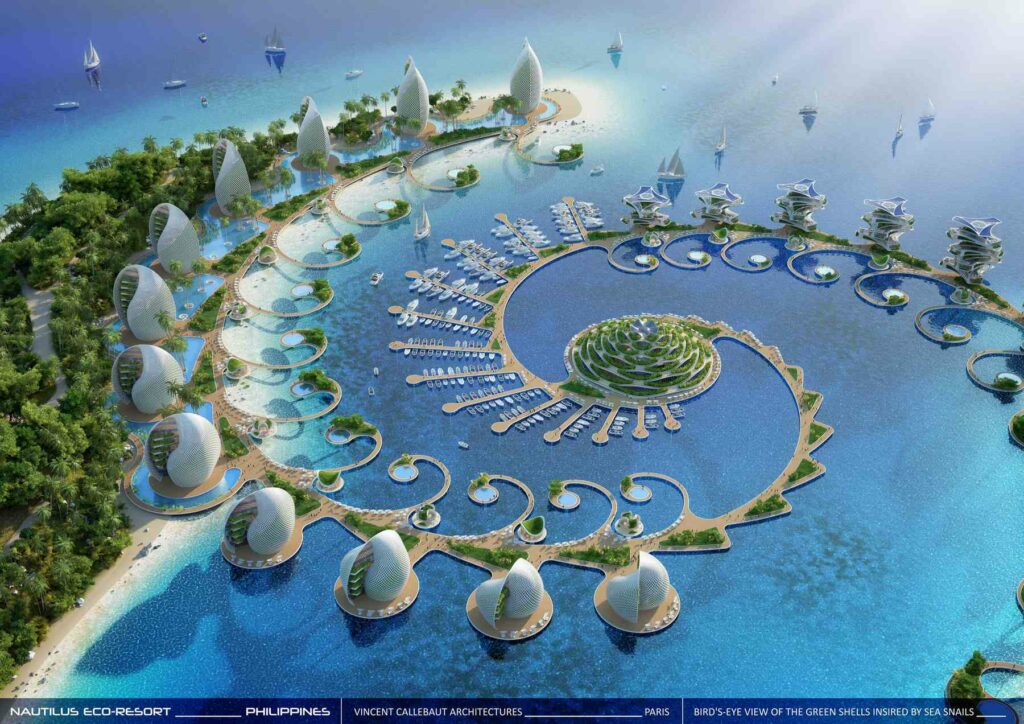
Latin America’s rapid urbanization has triggered profound challenges: escalating pollution, overpopulation, inefficient transportation systems, and a scarcity of green spaces. These problems, intensified by social, economic, and infrastructural limitations, necessitate a thorough overhaul of urban design to promote sustainability and resilience. In this critical context, innovative solutions are vital to reshape the region’s future metropolises. Belgian architect Vincent Callebaut provides a visionary response, merging technology, ecology, and urban planning to develop smart, sustainable cities. His proposals—self-sufficient buildings, vertical farms, and renewable energy systems—offer a foundation for a potential urban revolution in Latin America. This prompts the question: How can these ideas be tailored to the region’s distinct realities? This article explores Callebaut’s concepts and assesses their capacity to create more livable, sustainable urban environments in Latin America.
Vincent Callebaut, born in 1977, is a distinguished architect celebrated for his dedication to ecological architecture and sustainable urbanism. A graduate of the Victor Horta Institute of Architecture in Brussels, he has pioneered projects that seamlessly blend technology, nature, and futuristic design. His philosophy combines ecological architecture, sustainable urban planning, and biomimicry, focusing on resilient, self-sufficient urban centers. Utilizing state-of-the-art technologies, renewable energy, and sustainable materials, his designs aim to transform cities into vibrant, eco-friendly spaces. His numerous awards—Green Practitioner of the Year 2021, Best Execution Architecture 2023, and the Global Quality Silver Pyramid 2024—affirm his standing as a global leader in sustainable architecture.
For Callebaut, design and aesthetics play a central role in his work—not just as visual elements, but as expressions of a conceptual vision that integrates functionality, innovation, and beauty. His approach is distinguished by meticulous attention to detail and a seamless harmony between form and purpose, allowing his projects to transcend mere utility and become manifestations of a broader vision for the future. In this sense, his futuristic perspective is evident in his use of cutting-edge materials, emerging technologies, and concepts that anticipate evolving social, cultural, and environmental dynamics. Through his work, he not only envisions possible scenarios but brings them to life through designs that challenge conventional boundaries and propose new ways of interacting with the human environment.
Among his most representative works is the Taijitu project, designed in 2024—a sustainable sports center dedicated to the practice of Tai Chi Chuan. Located in Shenyang, China, on the banks of the Hunhe River, this 4,750 m² complex blends harmoniously with its natural surroundings. Inspired by the Yin-Yang symbol, its biomimetic architecture adopts a double-spiral form that reinterprets traditional curved wooden roof structures, adhering to the principles of balance and symmetry inherent in Chinese culture. The design reflects Callebaut’s philosophy, which seamlessly integrates sustainability, biomimicry, and advanced technology to create highly innovative projects.
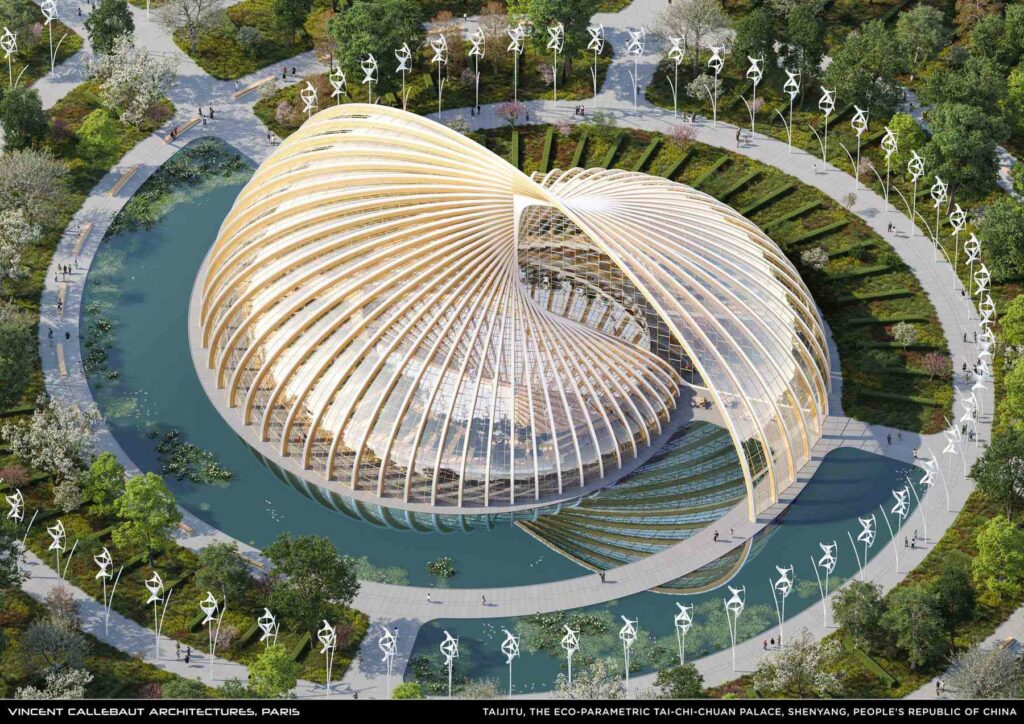
Fuente: https://vincent.callebaut.org/object/241011_taijitu/taijitu/projects
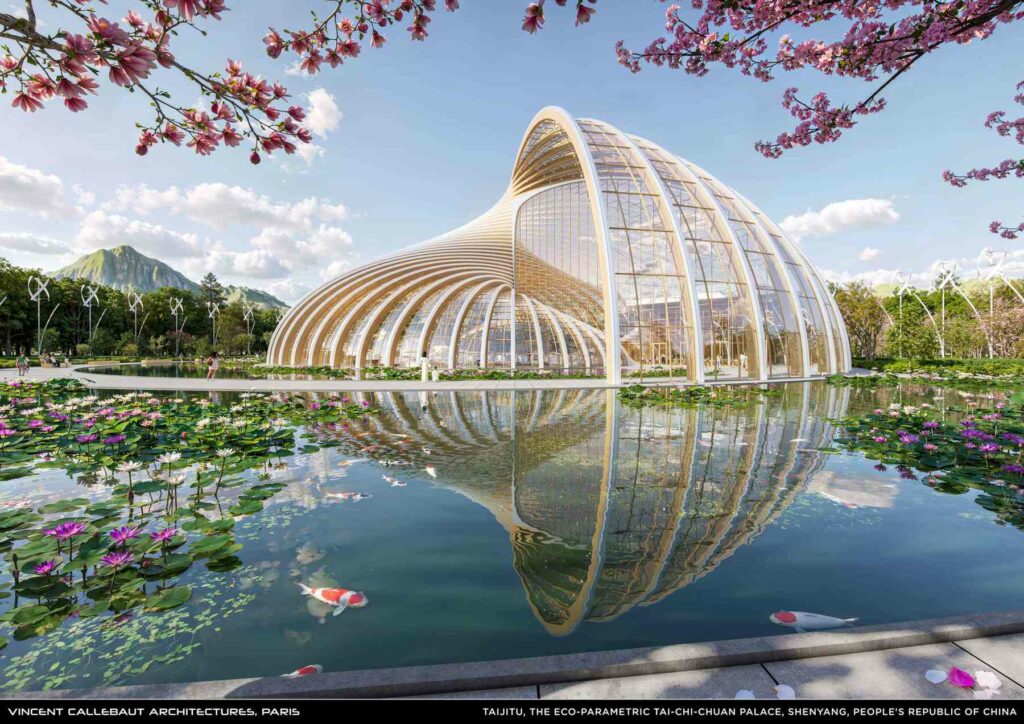
Fuente: https://vincent.callebaut.org/object/241011_taijitu/taijitu/projects
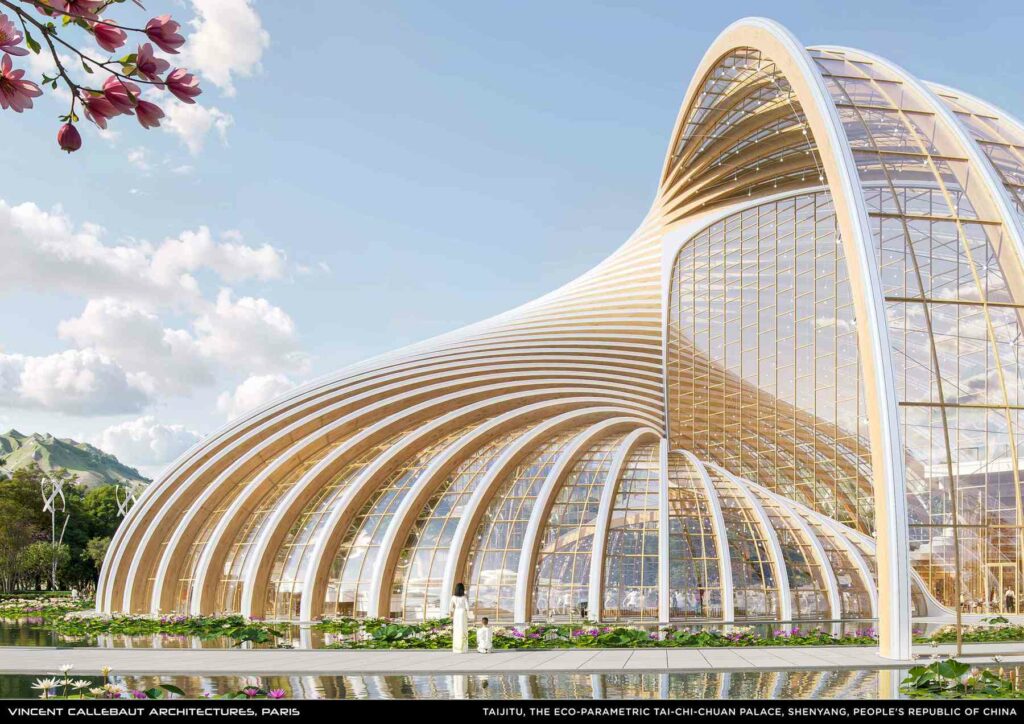
Fuente: https://vincent.callebaut.org/object/241011_taijitu/taijitu/projects
The Dune project (2025), in turn, is an innovative biomimetic architecture proposal that merges urbanism, ecology, and technology to create a self-sufficient and climate-resilient environment. Inspired by the organic forms of dunes and coastal ecosystems, this design incorporates sustainable materials, renewable energy, and natural ventilation systems to optimize resource consumption. With a structure designed to support environmental regeneration, Dune seeks to redefine the relationship between cities and nature, promoting an urban habitat model in harmony with the planet.
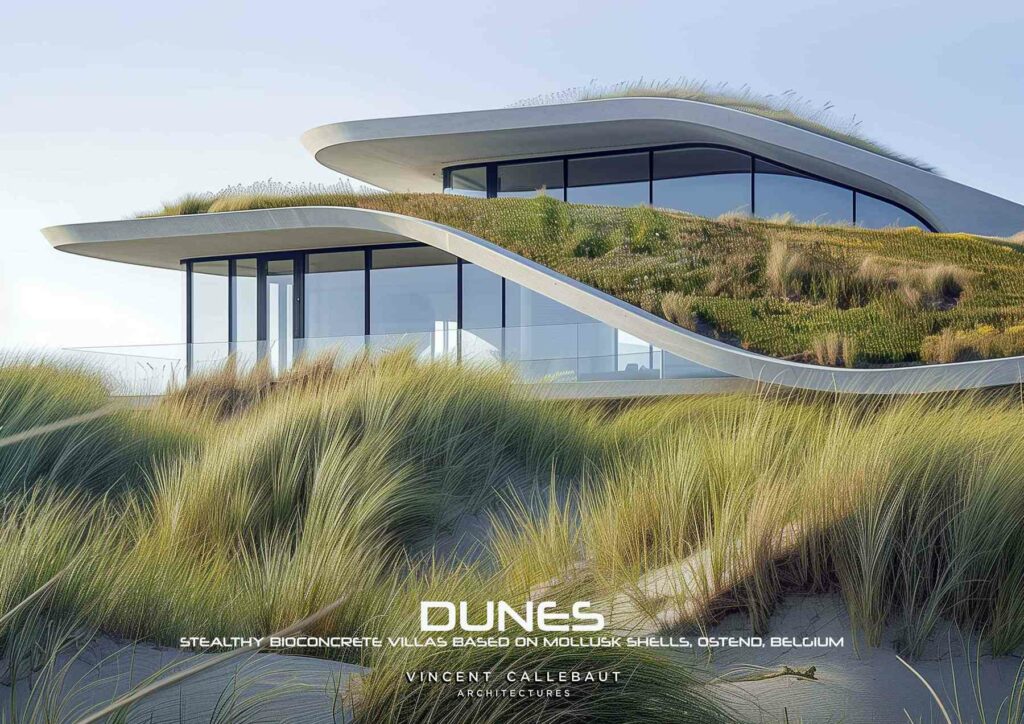
Fuente: https://vincent.callebaut.org/object/240325_dunes/dunes/projects
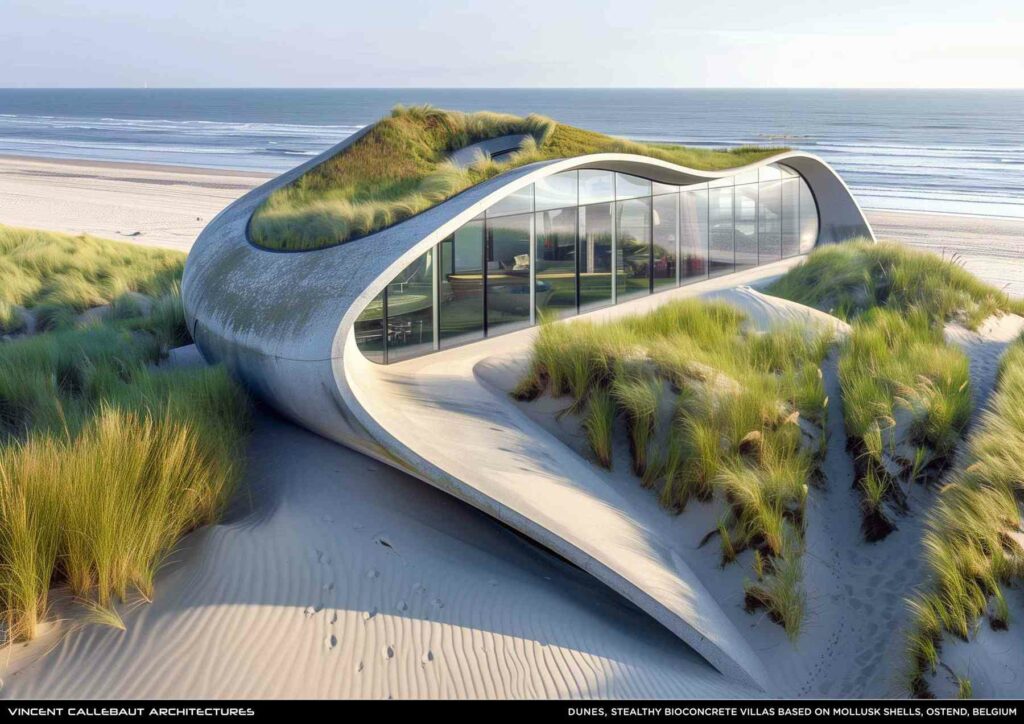
Fuente: https://vincent.callebaut.org/object/240325_dunes/dunes/projects
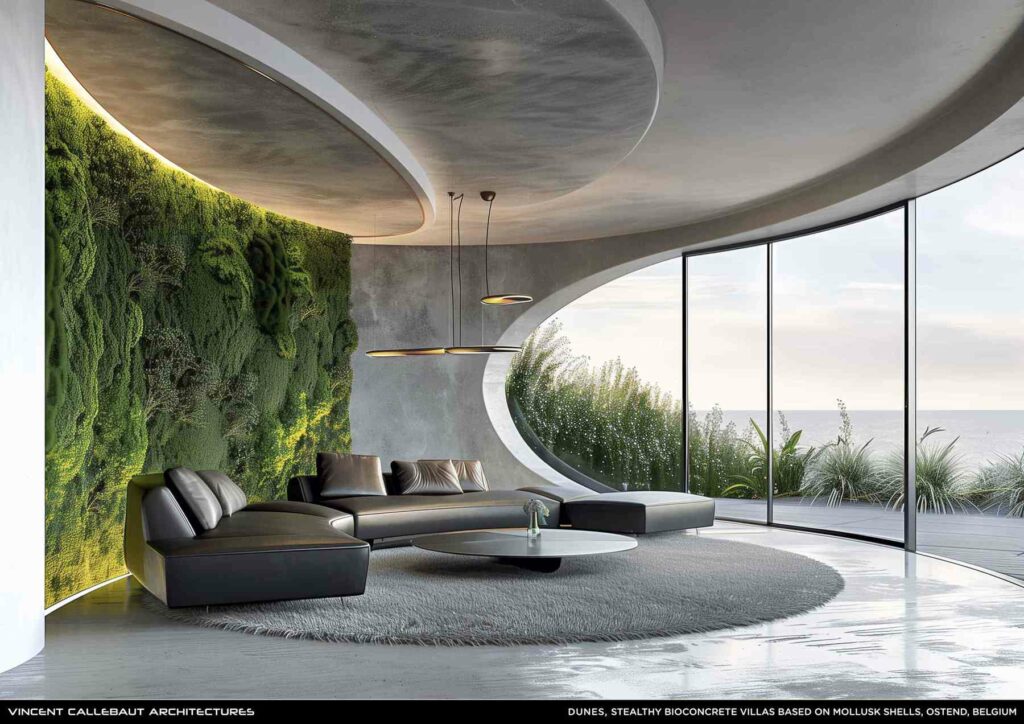
Fuente: https://vincent.callebaut.org/object/240325_dunes/dunes/projects
These projects open a pathway for reflection on housing construction in Latin America. The use of recycled materials and innovative techniques, such as self-healing bioconcrete, could provide viable alternatives for developing more durable and sustainable social housing in the region. Likewise, the incorporation of renewable energy, green roofs, and urban farms could enhance the quality of life in densely populated areas. A biomimetic and energy self-sufficiency approach would allow Latin American cities not only to expand but to do so in harmony with their surroundings, simultaneously addressing environmental and social challenges.
Beyond individual architecture, Callebaut envisions large-scale projects that transform urban planning with a futuristic perspective and an ethic of harmony with nature. A notable example is the Nautilus Eco-Resort, located in Palawan, Philippines. Designed as a biomimetic learning center with zero emissions, zero waste, and zero poverty, this sustainable complex merges ecological architecture with responsible tourism. Featuring 12 spiral towers and modular structures, it integrates renewable technologies such as solar and wind energy, along with water and waste recycling systems. This design aims to foster biodiversity and environmental education, offering a model of self-sufficient and environmentally respectful development.

Fuente: https://vincent.callebaut.org/object/170831_nautilusecoresort/nautilusecoresort/projects
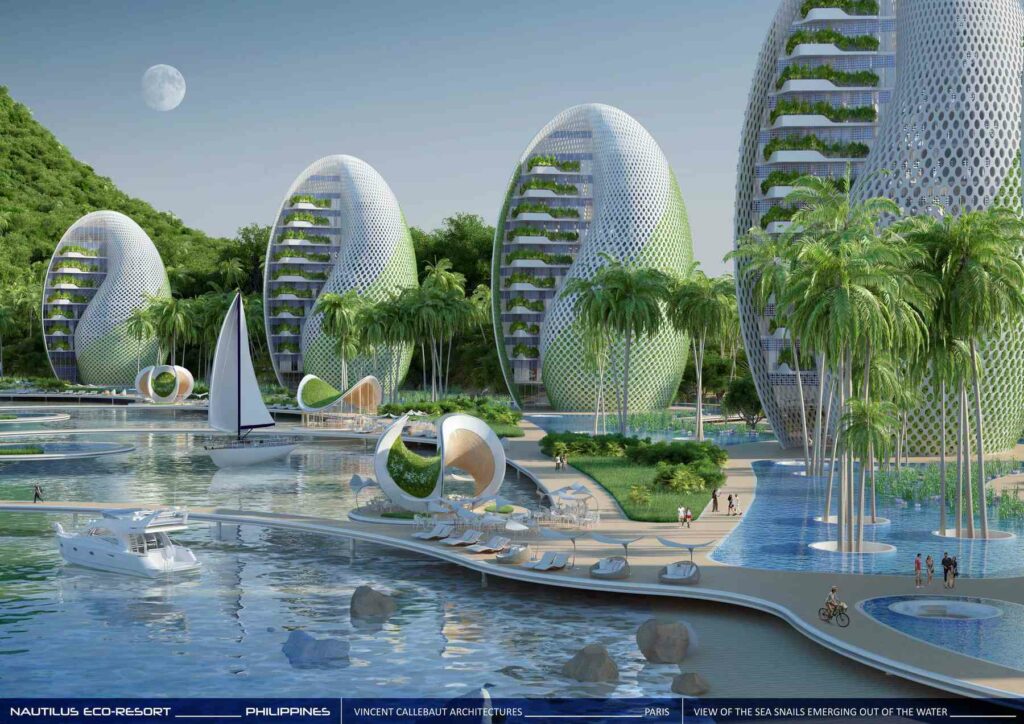
Fuente: https://vincent.callebaut.org/object/170831_nautilusecoresort/nautilusecoresort/projects
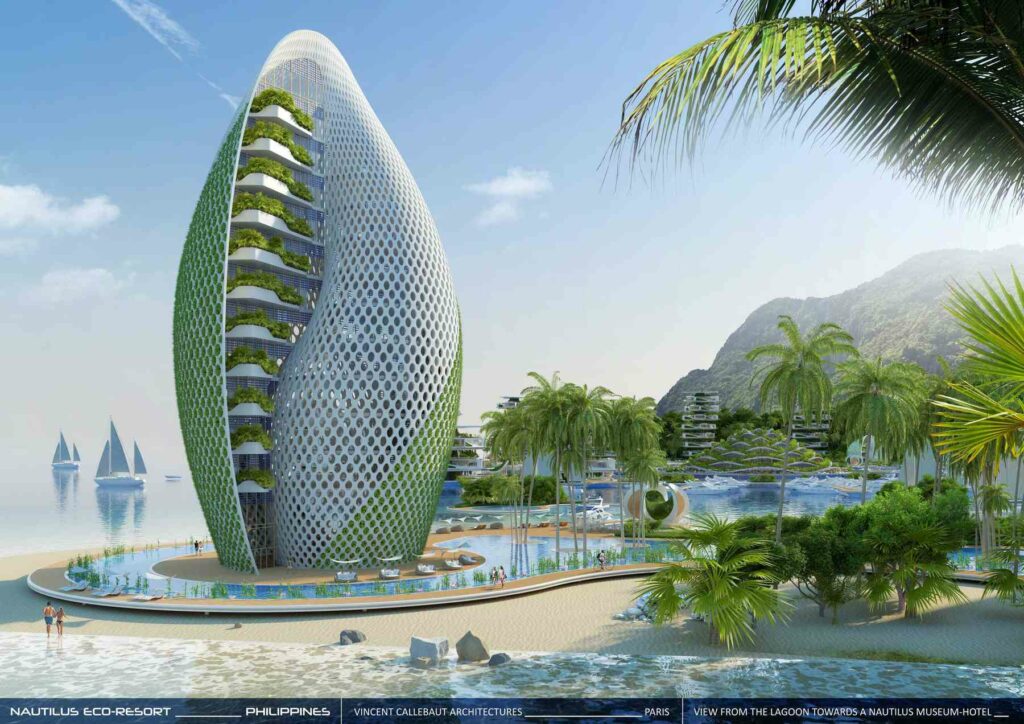
Fuente: https://vincent.callebaut.org/object/170831_nautilusecoresort/nautilusecoresort/projects
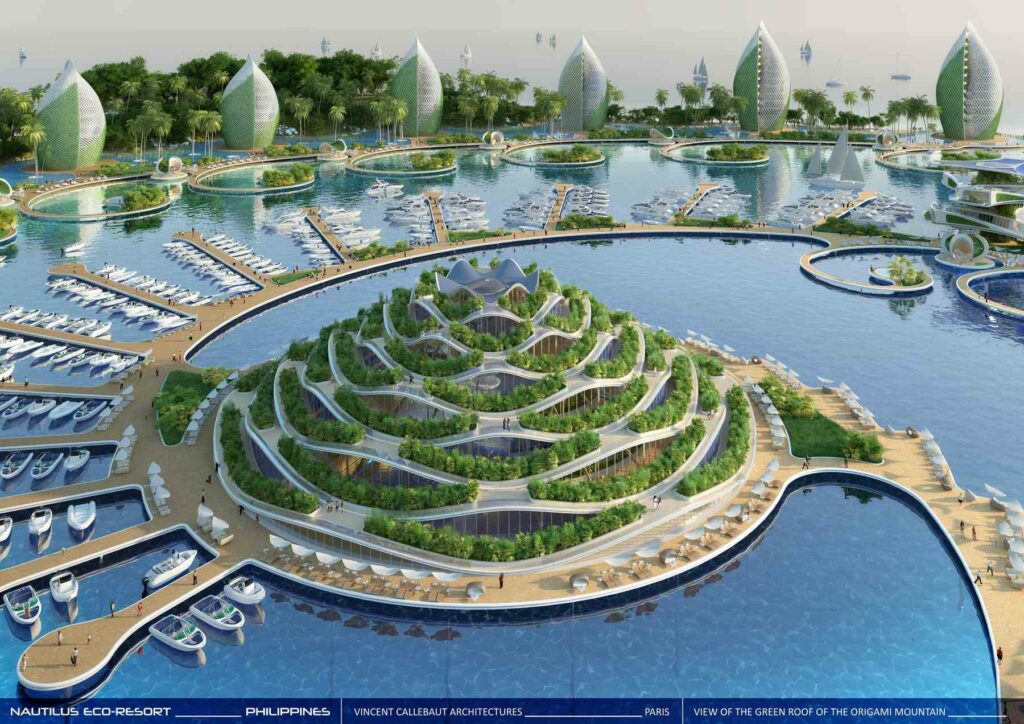
Fuente: https://vincent.callebaut.org/object/170831_nautilusecoresort/nautilusecoresort/projects
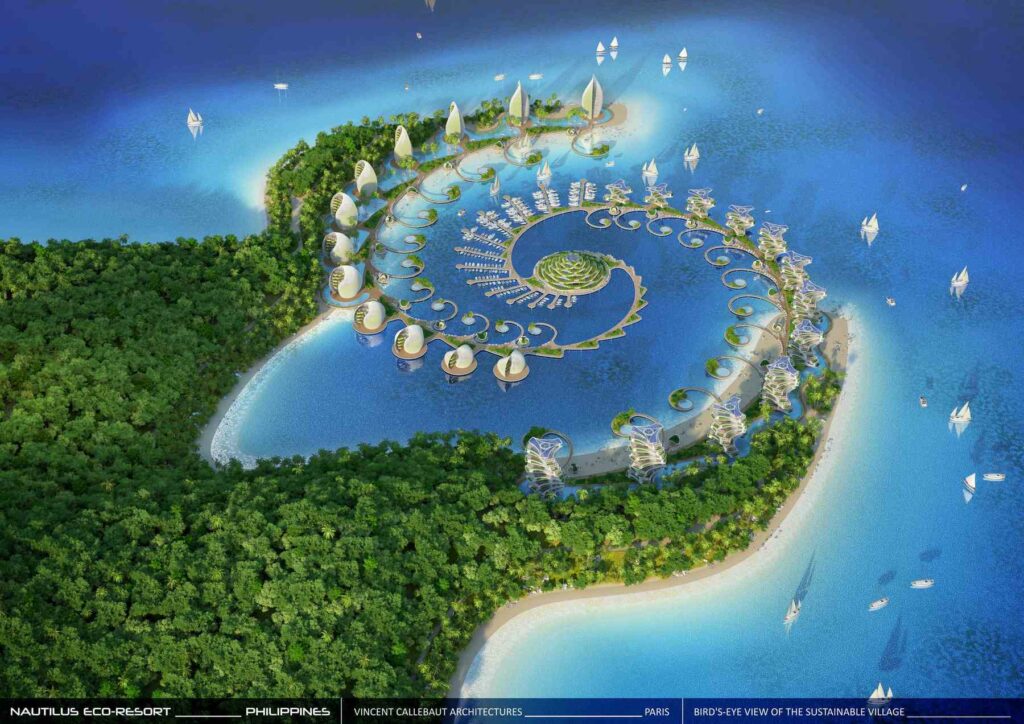
Fuente: https://vincent.callebaut.org/object/170831_nautilusecoresort/nautilusecoresort/projects
In the Latin American context, these types of designs could have a transformative impact on coastal regions vulnerable to climate change and environmental degradation. Biomimetic proposals that integrate renewable energy and recycling could help mitigate the effects of mass tourism and uncontrolled growth in the Mexican Caribbean, the Colombian coasts, and Central American islands. Moreover, by generating green jobs and fostering resilience to extreme climate events, these initiatives would provide solutions tailored to local needs.
Along the same lines of marine- and ocean-focused innovation, the Lilypad project represents a groundbreaking proposal for a sustainable floating city designed to address the challenges of climate change and rising sea levels. Inspired by the shape of a lotus flower, this city aims to be a self-sufficient refuge for climate refugees, providing housing, community spaces, and agricultural areas. Its design incorporates advanced ecological technologies, including energy generation from solar, wind, and geothermal sources, as well as seawater desalination for potable water supply. The structure is designed to adapt to aquatic environments, featuring floating platforms capable of adjusting to fluctuations in water levels.
This project embodies Callebaut’s vision of a future where cities not only adapt to environmental conditions but also offer innovative solutions to the global climate crisis. In the Latin American context, particularly in coastal regions vulnerable to rising sea levels and the impacts of climate change, Lilypad could present a viable alternative. Countries such as Colombia, Mexico, Peru, and the Caribbean island nations face severe risks due to sea level rise and the intensification of extreme weather events. The possibility of floating, self-sufficient living spaces could help alleviate pressure on densely populated urban areas, mitigating the adverse effects of uncontrolled urbanization in these regions.
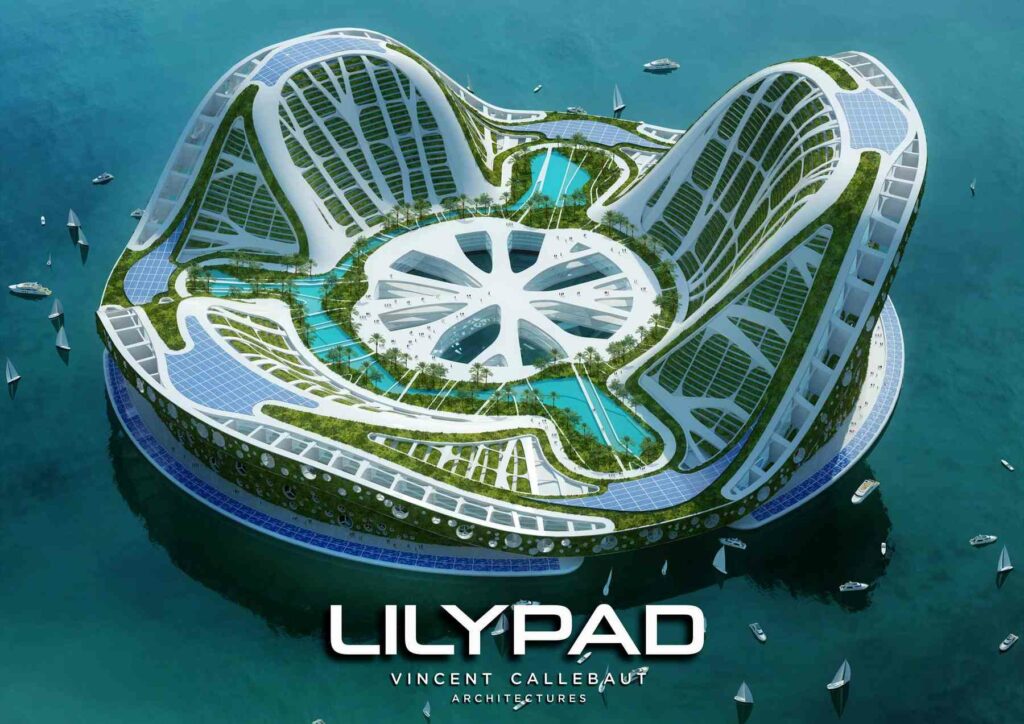
Fuente: https://vincent.callebaut.org/object/080523_lilypad/lilypad/projects
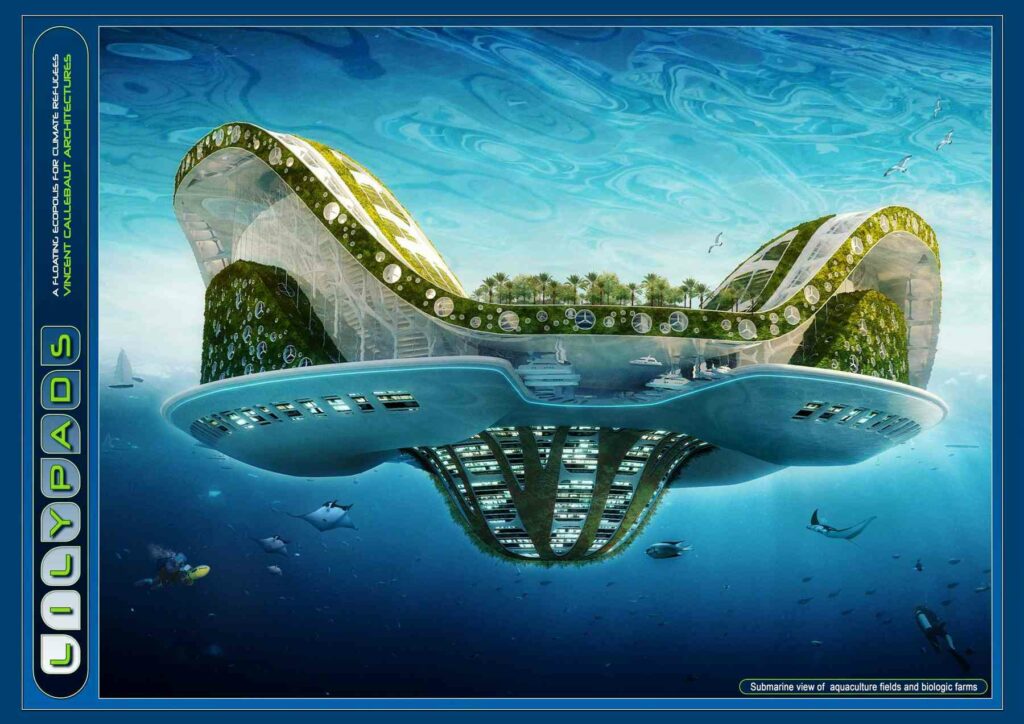
Fuente: https://vincent.callebaut.org/object/080523_lilypad/lilypad/projects
The Dragonfly project presents a futuristic concept of a sustainable skyscraper, inspired by nature and designed to transform the urban landscape through innovative and eco-friendly architecture. Its structure, reminiscent of a dragonfly’s form, features wings engineered to maximize the capture of solar and wind energy, enabling the building to operate self-sufficiently. Additionally, it integrates green technologies such as solar panels, wind turbines, and water recycling systems, creating an autonomous urban ecosystem that accommodates residential, commercial, and vertical farming spaces.
With this proposal, Callebaut envisions a future in which buildings not only fulfill conventional functions but also actively contribute to the regeneration of the urban environment. The application of such projects in major Latin American cities could have a significant impact, particularly in São Paulo, Mexico City, Buenos Aires, and Bogotá, where rapid urban growth has led to critical issues such as pollution, traffic congestion, and resource scarcity. The incorporation of sustainable urban models could provide a viable solution to these challenges. Integrating renewable energy, recycling systems, and urban agriculture into contemporary architecture would help reduce cities’ ecological footprints and improve the quality of life for their inhabitants.
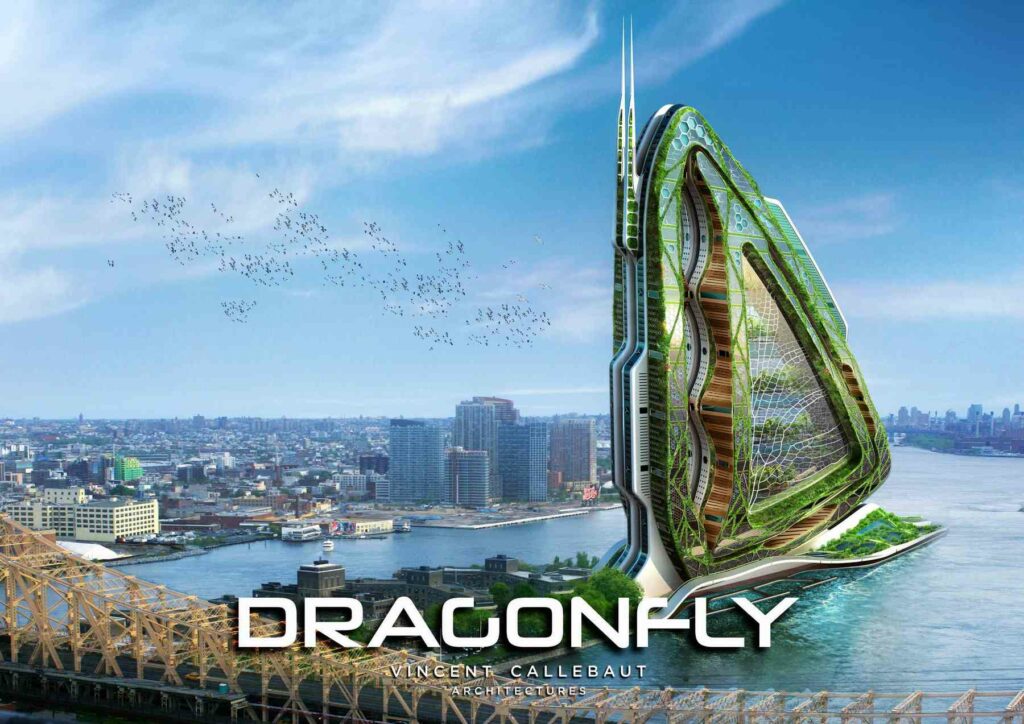
Fuente: https://vincent.callebaut.org/object/090429_dragonfly/dragonfly/projects
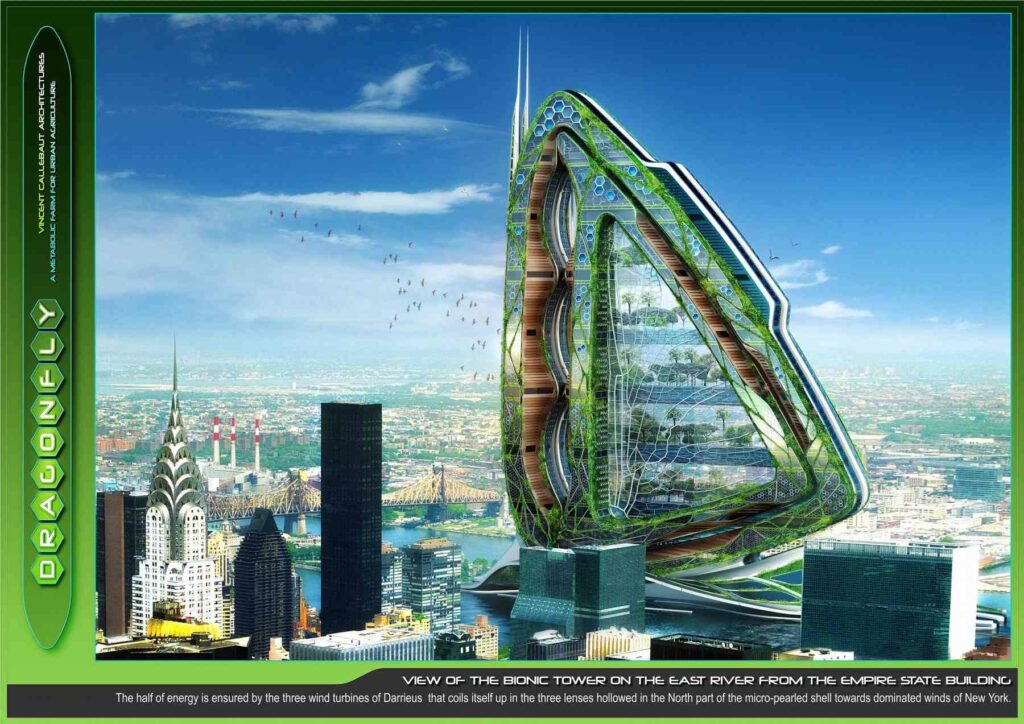
Fuente: https://vincent.callebaut.org/object/090429_dragonfly/dragonfly/projects
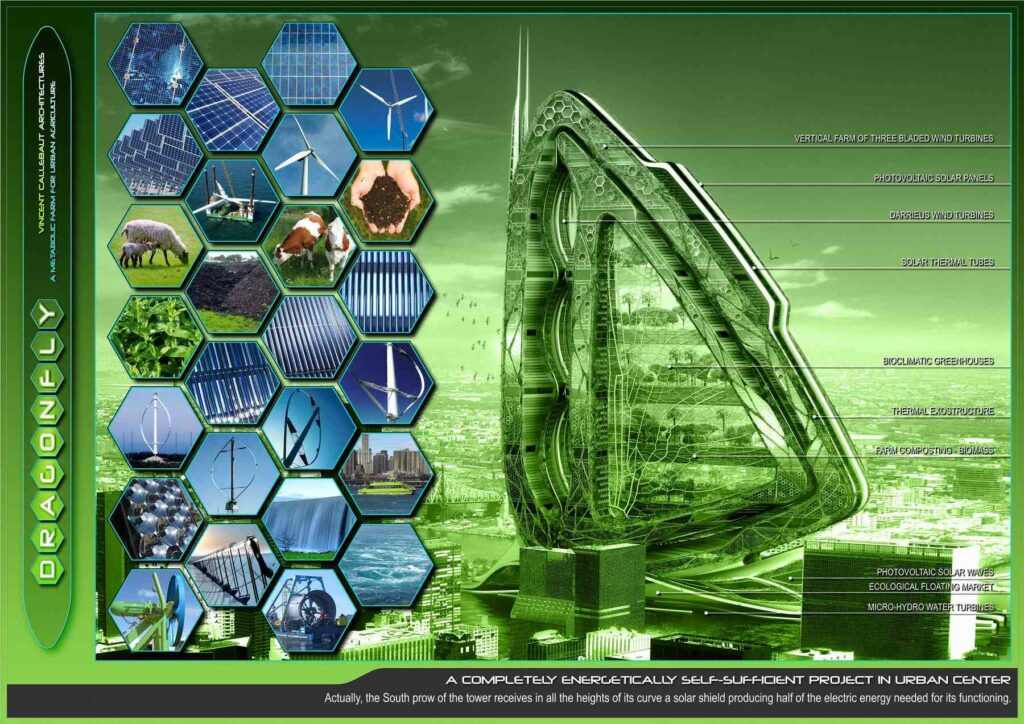
Fuente: https://vincent.callebaut.org/object/090429_dragonfly/dragonfly/projects
This vision of urban transformation is also reflected in other projects by Callebaut, such as Hyperion and Paris Smart City 2050. Hyperion is an ecological skyscraper concept inspired by the form of a tree, designed to integrate renewable energy and water recycling systems to generate a positive impact on both the environment and urban life.
Meanwhile, Paris Smart City 2050 is a visionary model of a smart and sustainable city that combines advanced architecture, intelligent mobility, efficient resource management, and the integration of green spaces to create resilient and self-sufficient urban environments in the face of climate change challenges. Both projects represent a synthesis of technology, nature, and urban design, shaping a paradigm of sustainable cities for the future.
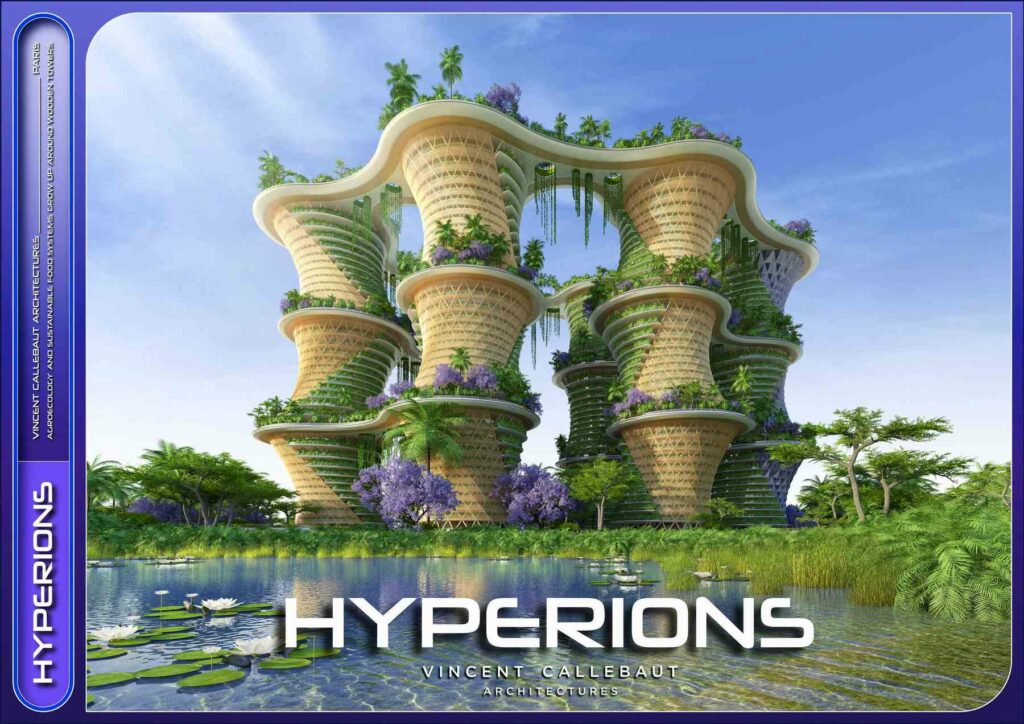
Fuente: https://vincent.callebaut.org/object/160220_hyperions/hyperions/projects
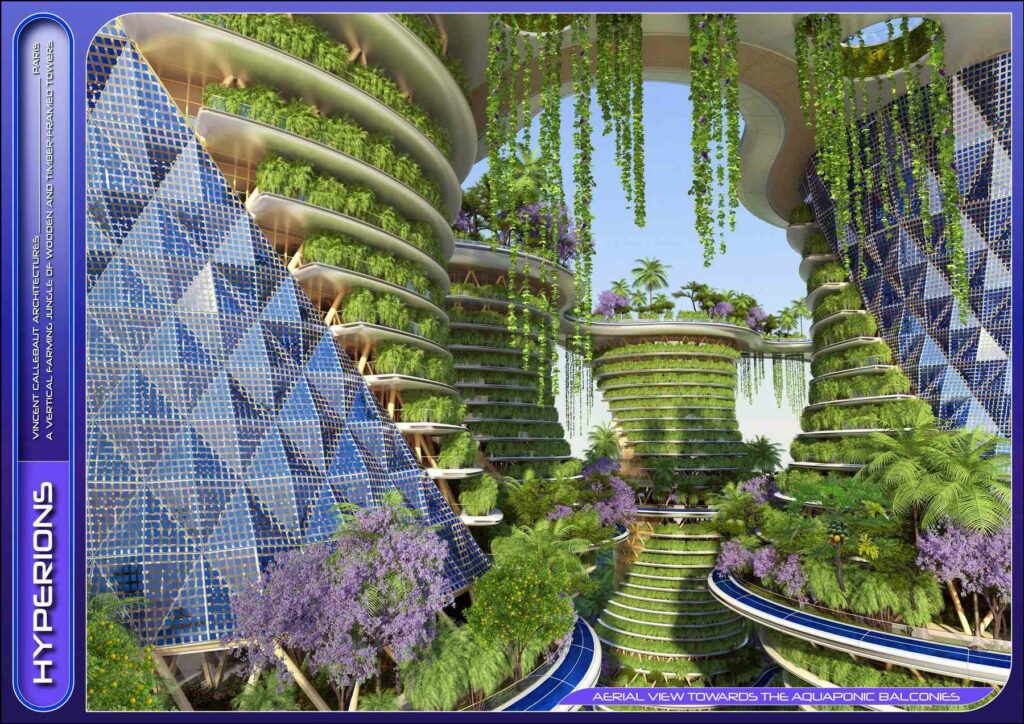
Fuente: https://vincent.callebaut.org/object/160220_hyperions/hyperions/projects
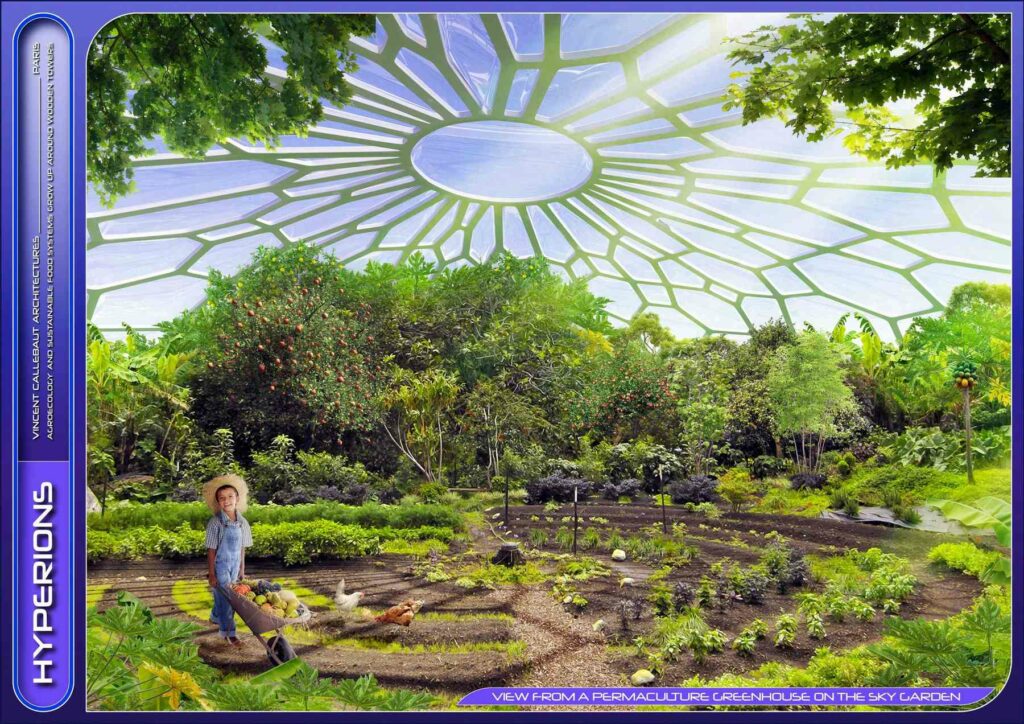
Fuente: https://vincent.callebaut.org/object/160220_hyperions/hyperions/projects
In this context, the Paris Smart City 2050 project could serve as a reference for the modernization of cities in Latin America. In a region characterized by rapid urban growth, high levels of inequality, and environmental challenges such as pollution and deforestation, Callebaut’s vision offers adaptable solutions. His proposals include self-sufficient buildings powered by solar or wind energy, the integration of green spaces to mitigate urban heat, and local food production to reduce dependence on external supply chains.
Megacities such as Bogotá, Mexico City, and São Paulo could benefit from these ideas to ease pressure on resources, improve air quality, and promote a circular economy. The key lies in adapting these designs to local conditions, addressing specific challenges such as tropical rainfall management and the use of regional materials and labor, ensuring a balance between innovation and cultural context.
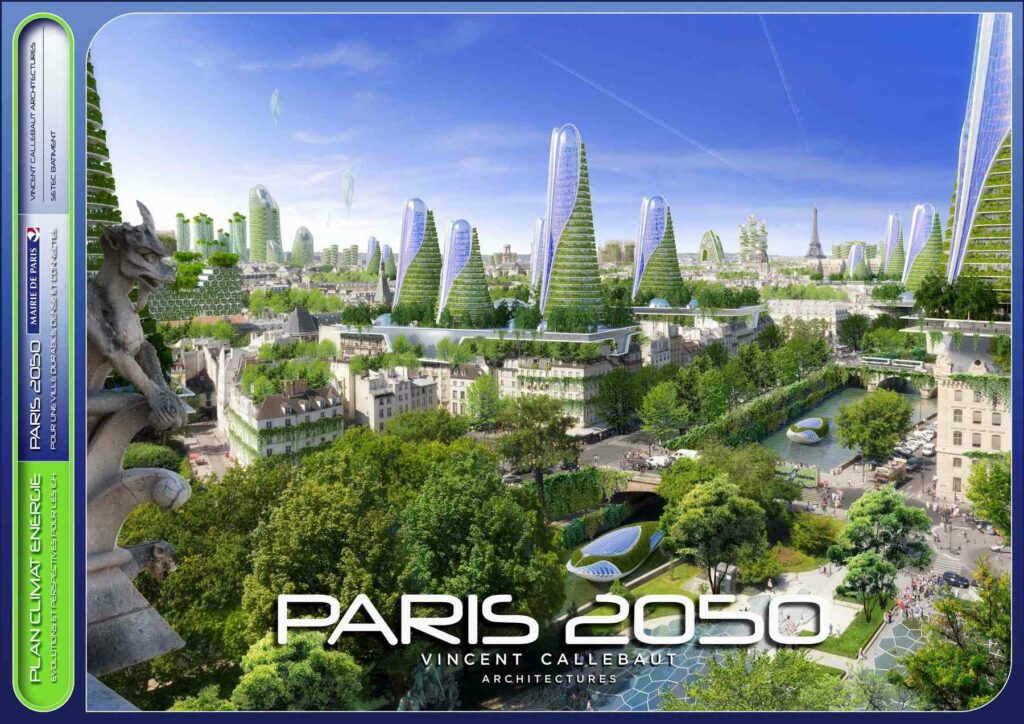
Fuente: https://vincent.callebaut.org/object/150105_parissmartcity2050/parissmartcity2050/projects

Fuente: https://vincent.callebaut.org/object/150105_parissmartcity2050/parissmartcity2050/projects
Another of his most recent works is Écume des Ondes (2024) in Aix-les-Bains, France, a transformation of the old thermal baths into a sustainable wellness center with undulating green terraces and an aquaponic farm. Flower Tower (2024) in Brussels is a hybrid wooden hospital that prioritizes biophilic design, while Harmocracy (2024) in Neom, Saudi Arabia, is a futuristic airport that optimizes solar energy and natural ventilation.
Innovative proposals also include Green Line (2023) in Geneva, a car-free eco-district with cascading wooden villas, and Green New Deal (2023) in New York, which reimagines the city with vertical villages designed to reduce emissions by 85% by 2050. In 2022, Manta Ray (Seoul) transformed a disused highway into a productive space with agricultural bridges, while Archibiotec (Paris) created an urban distillery that converts waste into biofuels.
Meanwhile, Pollinator Park (2020), commissioned by the European Commission, is a virtual park that educates visitors on the importance of pollinators through organic structures simulating natural ecosystems. Conceptual projects such as Hydrogenase (2008) envision zero-emission airships powered by biohydrogen from algae, while Physalia (2007) is a floating garden vessel designed to purify European rivers using solar energy and biofiltration. Perfumed Jungle (2006) in Hong Kong transforms the waterfront into a «green lung» with interwoven ecological towers. Anti-Smog (2005) in Paris, France, is an ecological center that purifies the air through green technologies and biomimetic design. Lastly, Elasticity (2001), an academic project, proposed an autonomous aquatic city for 50,000 people, marking the beginning of Callebaut’s futuristic vision.
However, implementing these designs in Latin America presents multiple challenges. The uncontrolled expansion of cities and the proliferation of informal settlements complicate sustainable infrastructure planning. Additionally, economic inequality limits equitable access to ecological technologies. Environmental conditions—such as air pollution, deforestation, and climate variability—require specific architectural adaptations to optimize resource management across diverse climates. The integration of a circular economy and the use of local materials can help reduce costs and promote regional employment, but their implementation necessitates structural changes in production and consumption models. Finally, technological infrastructure and community training are essential to ensuring the long-term sustainability of these projects.
Consequently, a comprehensive approach is required—one that combines innovation, inclusive public policies, and contextual strategies that address the specific needs of each region.
Callebaut’s urban vision offers an innovative framework for rethinking the design of future cities, integrating technology, ecology, and functionality into a model of sustainable urbanism. His proposals not only anticipate the challenges of climate change and urban expansion but also present viable solutions to reduce environmental impact and improve quality of life in densely populated environments. In the Latin American context, where cities face structural issues such as inequality, pollution, and infrastructure deficits, adapting these concepts is crucial. However, their implementation demands coordinated public policies, technological investment, and a shift in urban planning that prioritizes sustainability and resilience.
Beyond aesthetics and architectural innovation, the real challenge lies in transforming these ideas into tangible, accessible solutions tailored to local realities. The future of cities will depend on the ability to merge vision with action, adopting strategies that enable a balanced development between urban growth and environmental preservation.
Note: I am deeply grateful to Professor Carolina Espitia for highlighting the importance of climate change awareness through the Latin American Chair of Environmental Thought and Climate Crisis at Universidad Central. Her guidance has inspired me to reflect and take action toward a sustainable future.
References: Callebaut, V. (2025). Projects. Vincent Callebaut Architectures. https://vincent.callebaut.org/




Deja una respuesta